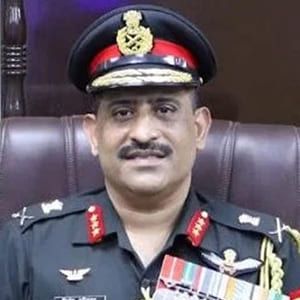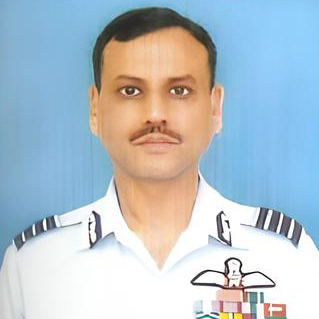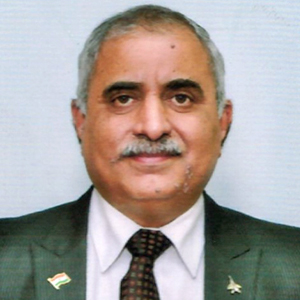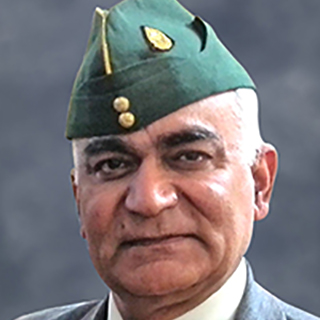SPONSORS




EXHIBITORS
PAST SPONSORS




PAST EXHIBITORS


| Download Information Brochure (↓) |
The Centre for Air Power Studies and Indian Military Review will organise Unmanned Aerial Systems and Counter-UAS seminar & exhibition on 2 May 2025 at the Air Force Auditorium, New Delhi.
Impact of Drones on Military Operations
Drones continue to evolve with advancements in artificial intelligence, autonomy, and sensor technology, further enhancing their military applications. Their cost-effectiveness and ability to minimize risks to human personnel make them indispensable in modern warfare.
Russia and Ukraine have both sides have utilized drones to gain strategic advantages in reconnaissance, precision strikes, and psychological operations. The innovative use of UAVs has not only changed the dynamics of the conflict but also demonstrated the transformative impact of drones in modern warfare.
Drone Mission
- In recent years drones have been used for monitoring troop movements, gather intelligence, and providing real-time battlefield awareness.
- A U.S. MQ-9 Reaper drone conducted a precision strike near Baghdad International Airport, in 2020, killing Iranian General Qasem Soleimani in a highly targeted operation.
- During U.S. withdrawal operations, drones like the Skyborg and experimental UAVs were tested for delivering medical supplies to remote bases in Afghanistan.
- Azerbaijan employed Harop loitering munitions (kamikaze drones), in 2020, to suppress and destroy Armenian air defense systems by jamming and targeting their radar systems.
- Drones equipped with thermal imaging were used to locate survivors in the rubble during post-earthquake rescue operations in Turkey in 2023.
- The U.S. military used drones to broadcast messages and warnings to ISIS fighters, in Iraq in 2014-19, urging them to surrender during operations in Mosul.
- US MQ-4C Triton UAV conducted maritime patrols and monitored Chinese naval activities in disputed waters, in South China Sea, enhancing situational awareness.
- Houthi forces used coordinated drone swarms to attack Saudi Aramco oil processing facilities in Abqaiq, in 2019, overwhelming defenses and causing significant damage.
- U.S. drones were deployed, in Syria in 2017, to monitor areas suspected of chemical weapon use, including gathering atmospheric data to confirm the presence of sarin gas.
- Following hurricane Maria in Puerto Rico, drones like the AeroVironment Puma were used as communication relays to establish connectivity in isolated areas where infrastructure was destroyed.
Scope of Employment
Unmanned Aerial Vehicles (UAVs) or drones, have become integral to modern military operations. They are versatile platforms that can be used for a variety of missions. Key military uses of drones include the following:
a. Intelligence, Surveillance, and Reconnaissance (ISR).
- Real-time Monitoring: UAVs provide real-time imagery and data for battlefield awareness.
- Target Identification: They help identify enemy positions, movements, and assets.
- Border Surveillance: Drones monitor and secure national borders against infiltration.
b. Precision Strikes and Combat Missions.
- Armed UAVs: Equipped with precision-guided munitions for targeting high-value targets.
- Suppression of Enemy Air Defenses (SEAD): Some drones are designed to neutralize enemy radar and missile systems.
- Close Air Support: UAVs provide support for ground forces in combat zones.
c. Logistics and Supply Delivery.
- Battlefield Resupply: Transporting ammunition, medical supplies, or rations to remote or high-risk areas.
- Casualty Evacuation: Experimental systems are being tested for unmanned casualty evacuation.
d. Electronic Warfare (EW).
- Signal Jamming: UAVs can disrupt enemy communications and radar systems.
- Cyber Operations: Some advanced drones can conduct cyber attacks or collect signals intelligence (SIGINT).
e. Training and Simulation.
- Target Practice: UAVs are used as targets for training air defense systems and pilots.
- Operational Drills: They simulate adversary actions during military exercises.
f. Search and Rescue (SAR).
- Disaster Zones: UAVs locate survivors and assess damage in combat or disaster scenarios.
- Day/Night Operations: Thermal imaging-equipped drones enhance rescue capabilities in low visibility.
g. Psychological Operations (PsyOps).
- Loudspeaker Broadcasts: UAVs can disseminate propaganda or instructions in conflict zones.
- Demoralization: Persistent surveillance can have a psychological impact on adversaries.
h. Anti-Submarine and Maritime Operations.
- Maritime Patrol: Drones monitor coastal areas and shipping lanes for threats.
- Submarine Detection: Equipped with sonar systems to locate submarines.
- Mine Countermeasures: Identifying and neutralizing naval mines.
i. Swarm Tactics.
- Decoy Operations: Overwhelming enemy defenses using drone swarms.
- Force Multiplication: Coordinated swarms can attack multiple targets simultaneously.
k. Nuclear, Biological, and Chemical (NBC) Defence.
- Detection Systems: UAVs detect and monitor radioactive, chemical, or biological threats in hostile areas.
- Decontamination Support: Assisting in decontamination efforts remotely.
l. Communications Relay.
- Signal Extension: Acting as airborne relays for communication networks in challenging terrains.
- Network Support: Providing connectivity for forces operating in remote areas.
The following sessions are planned:
SESSION 1 - INAUGURAL SESSION (0930-1030hrs)
Welcome Address. Air Vice Mshl Anil Golani, Director General CAPS
Inaugural Address. Air Vice Mshl Jasvir Singh Mann, AVSM, VM, Director General (Weapon Systems), Air HQ.
Keynote Address. Lt Gen Vinod Nambiar, SM, Director General Army Aviation.
Drones - A Major military RMA. Maj Gen (Dr) GD Bakshi, SM, VSM, Retd. Editor IMR.
Release of Books and Release of EY-IMR Knowledge Paper.
Refreshments and Exhibition.
SESSION 2 - UAS REVOLUTIONIZING MODERN WARFARE (1100 – 1310 hrs)
Chairman: Air Vice Mshl Ashish Singh, VM, VSM, ACAS (Ops) Remote, Air HQ
Introduction to panelists and Chairman's Opening Remarks.
Review of UAS Operations in Contemporary Conflicts. Air Cmde Sandeep Singh VM, Air HQ
Industry Perspective. Col KV Kuber, Director Defence & Aerospace, E&Y.
Asymmetric Technologies and Emerging Trends in CUAS. Wg Cdr Pankaj Saxena, Chief Adviser Air Force, Big Bang Boom Solutions.
UAS & C-UAS : Future Trends, Opportunities and Challenges. Gp Capt Debabrata Dey (Retd), Aviation Safety and Technology, HC Robotics.
Advancing India's C-UAS Capabilities: Innovations, Integrations, and Indigenous Solutions. BM Chandrakanth, Sr GM Marketing & Sales, Astra Microwave Products Ltd.
Industry Perspective. Speaker from Garuda Aerospace
Lunch
SESSION 3 - SERVICES PLANS: THE FUTURE OF UNMANNED COMBAT (1400–1510 hrs)
Chairman: Air Vice Marshal Tejpal Singh, SM, VM, Asst Chief of Air Staff (Plans), Air HQ.
Introduction of panelists and Chairman's Opening Remarks
Progress on DRDO's UAS Projects. Christi V Jacob, Scientist G, ADE, DRDO.
Future Plans for Unmanned Combat Aerial Vehicles for IAF. Wg Cdr JS Virdi, Dte Air (Ops)
Army’s Tactical UAV Requirements. Col NR Choudhury, Inf-5, Infantry Directorate, Army HQ.
Navy's UAS and Future Plans. Cdr Siddhartha Gupta, Aviation Perspective Plg, NHQ.
SESSION 4 - DEFENDING AGAINST UNMANNED AERIAL THREATS (1515 – 1620 hrs)
Chairman: Maj Gen (Dr) Bipin Bakshi, Former IG Training, National Security Guard.
Introduction of panelists and Chairman's Opening Remarks
Counter UAS Ops. Air Mshl GS Bedi, AVSM, VM (G), VSM (Retd), Hony Distinguished Fellow, CAPS
Industry Presentation/ Countering the Threat from FPV drones. Col VS Salaria, Director AC-6, Armoured Corps Directorate, Army HQ
Counter UAS Solutions for IAF. Gp Capt G Sreenivas Prasad, Air HQ
SESSION 5 – EXPANDING UAS ROLES (1625 – 1720 hrs)
Chairman: Air Vice Mshl Ashish Vohra, VSM, Retd, Addl DG Centre for Air Power Studies
Introduction of panelists and Chairman's Opening Remarks
Development of Manned-Unmanned Teaming Concept. Gp Capt Kanav Bhartendu Air HQ
Extending Communication Networks in Remote Areas. Col TCS, Sigs Dte, Army HQ.
Closing Remarks. Air Vice Marshal Anil Golani, Director General CAPS
Vote of Thanks. Maj Gen Ravi Arora, Chief Editor, Indian Military Review.
Refreshments and dispersal.










Officers dealing with:
• UAS in Army, Navy, Air Force, Paramilitary
• Border management
• Surveillance; BSF, ITBP, CRPF, NSG
• Maritime & Coastal security; Coast Guard
• Critical National Infrastructure
• Special Operations
• Combat engineering, mining, bridging.
• Procurement of UAS
• Target Acquisition
• Training and simulation companies
• UAS operators
• Operational commanders
• Research & Development; DRDO
• Air Defence officers
• Counter-UAS officers
OFFICERS AVAILABLE FOR B2G INTERACTION
Intelligence, Surveillance, and Recce
• Real-time Monitoring
• Target Identification
• Border Surveillance
Precision Strikes & Combat Missions
• Armed UAVs
• Suppression of Enemy Air Defenses
• Close Air Support
Logistics and Supply Delivery
• Battlefield Resupply
• Casualty Evacuation
Electronic Warfare (EW)
• Signal Jamming
• Cyber Operationsand SIGINT
Training and Simulation
• Target Practice
• Operational Drills
Search and Rescue (SAR)
• Locate survivors and assess damage
• Day/Night Operations with TI
Psychological Operations
• Loudspeaker Broadcasts
• Demoralization with persistent surveillance
Anti-Submarine and Maritime Ops
• Maritime Patrol
• Submarine Detection
• Mine Countermeasures
Swarm Tactics
• Decoy Operations
• Force Multiplication
CBRN Defence
• Detection Systems
• Decontamination Support
Communications Relay
• Signal Extension
• Network Support
For Registered Users and Valid Pass Holders
Log-in with username "guest@mail.com" and password "guest"
If not already registered, buy a pass now from the options below.
